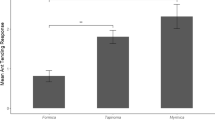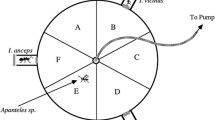Abstract
Partner quality can be crucial for the outcome of a mutualistic interaction. In multi-species associations, the characteristics of potential partners can vary substantially and thus the associated benefits. As a consequence of such variation, one might expect strategies of adjusting investments to the characteristics of a partner. Lycaenid butterfly larvae often interact mutualistically with several ant species of different size and aggressiveness and thereby different ability to protect the larvae. Attending ants are rewarded with nutritious secretions. Both ant behavior and a larva's need for protection are known to influence larval investment in the relationship. This study investigates the effect of six ant species on larval behavior in the lycaenid butterfly, Glaucopsyche lygdamus. The overall level of secretion, as well as the response to varying number of attending ants, were found to be influenced by ant species.
Similar content being viewed by others
References
Addicott, J.F. (1979) A multispecies aphid-ant association: density dependence and species-specific effects. Can. J. Zool. 57, 558-569.
Akino, T., Knapp, J.J., Thomas, J.A. and Elmes, G.W. (1999) Chemical mimicry and host specificity in the butterfly Maculinea rebeli, a social parasite of Myrmica ant colonies. Proc. R. Soc. Lond. B 266, 1419-1426.
Andersen, M. (1991) An ant-aphid interaction: Formica fusca and Aphthargelia symphoricarpi on Mount St. Helens. Am. Midl. Nat. 125, 29-36.
Axén, A.H., Leimar, O. and Hoffman, V. (1996) Signalling in a mutualistic interaction. Anim Behav. 52, 321-333.
Axén, A.H. and Pierce, N.E. (1998) Aggregation as a cost-reducing strategy for lycaenid larvae. Behav. Ecol. 9, 109-115.
Bhatkar, A. and Whitcomb, W.H. (1971) Artificial diet for rearing various species of ants. Fla. Entomol. 53, 229-232.
Ballmer, G.R. and Pratt, G.F. (1991) Quantification of ant attendance (Myrmecophily) of lycaenid larvae. J. Res. Lepid. 30, 95-112.
Boyd, R. (1992) The evolution of reciprocity when conditions vary. In A.H. Harcourt and F.B.M. de Waal (eds) Coalitions and Alliances in Humans and other Animals. Oxford University Press, Oxford, pp. 473-489.
Bristow, C.M. 1984. Differential benefits from ant attendance to two species of Homoptera on New York ironwood. J. Anim. Ecol. 53, 715-726.
Bronstein, J.L. (1994a) Our current understanding of mutualism. Quart. Rev. Biol. 69, 31-51.
Bronstein, J.L. (1994b) Conditional outcomes in mutualistic interactions. Trends Ecol. Evol. 9, 214-217.
Buckley, R.C. (1987) Interactions involving plants, homoptera, and ants. Ann. Rev. Ecol. Syst. 18, 111-135.
Burghardt, F. and Fiedler, K. (1996a) The influence of diet on growth and secretion behaviour of myrmecophilous Polyommatus icarus caterpillars (Lepidoptera: Lycaenidae). Ecol. Entomol. 21, 1-8.
Burghardt, F. and Fiedler, K. (1996b) Myrmecophilous behaviours in caterpillars of the butterfly, Polyommatus icarus (Rottemburg, 1775): temporal patterns and age dependency (Lepidoptera: Lycaenidae). Nota lepid. 19, 212-229.
Carroll, C.R. and Janzen, D.H. (1973) Ecology of foraging by ants. Ann. Rev. Ecol. Syst. 4, 231-257.
Cherix, D. (1987) Relationship between diet and polyethism in Formica colonies. Experientia Supplementum (Behavior in Social Insects) 54, 93-115.
Cottrell, C.B. (1984) Aphytophagy in butterflies: its relationship to myrmecophily. Zool. J. Linn. Soc. 79, 1-57.
Cushman, J.H. and Whitham, T.G. (1989) Conditional mutualism in a membracid-ant association: temporal, age-specific, and density-dependent effects. Ecology 70, 1040-1047.
de Waal, F.B.M. (1989) Food sharing and reciprocal obligations among chimpanzees. J. Hum. Evol. 18, 433-459.
Eastwood, R. and Fraser, A.M. (1999) Associations between lycaenid butterflies and ants in Australia. Aust. J. Ecol. 24, 503-537.
Edinger, B.B. (1987) Species-specific differences and conditional mutualism in aphid tending ants. Ph.D. Thesis, University of Minnesota, 150 pp.
Elmes, G.W., Thomas, J.A. and Wardlaw, J.C. (1991) Larvae of Maculinea rebeli, a large-blue butterfly, and their Myrmica host ants: wild adoption and behaviour in ant-nests. J. Zool., Lond. 223, 447-460.
Fiedler, K. (1991) Systematic, evolutionary, and ecological implications of myrmecophily within the Lycaenidae (Insecta: Lepidoptera: Papilionoidea). Bonner Zool. Monogr. 31, 1-210.
Fiedler, K. and Hagemann, D. (1995) The influence of larval age and ant number on myrmecophilous interactions of the African grass blue butterfly, Zizeeria knysna (Lepidoptera: Lycaenidae). J. Res. Lepid. 31, 213-232.
Fiedler, K. and Hummel, V. (1995) Myrmecophily in the brown argus butterfly, Aricia agestis (Lepidoptera: Lycaenidae): effects of larval age, ant number and persistence of contact with ants. Zoology 99, 128-137.
Fiedler, K. and Maschwitz, U. (1987) Functional analysis of the myrmecophilous relationships between ants (Hymenoptera: Formicidae) and lycaenids (Lepidoptera: Lycaenidae). III. New aspects of the function of the retractile tentacular organs of lycaenid larvae. Zool. Beitr. N. F. 31, 409-416.
Fischer, E.A. (1980) The relationship between mating system and simultaneous hermaphroditism in the coral reef fish, Hypoplectrus nigricans (Serranidae). Anim Behav. 28, 620-633.
Fraser, A.M. (1997) Evolution of specialization in lycaenid butterfly-ant mutualisms. Ph.D. Thesis, Harvard University, 128 pp.
Fraser, A.M., Axén, A. H. and Pierce, N. E. (2001) Assessing the quality of different ant species as partners of a myrmecophilous butterfly. Oecologia, in press.
Henning, S.F. (1983) Chemical communication between lycaenid larvae (Lepidoptera: Lycaenidae) and ants (Hymenoptera: Formicidae). J. Entomol. Soc. S. Afr. 46, 341-366.
Itioka, T. and Inoue, T. (1999) The alternation of mutualistic ant species affects the population growth of their trophobiont mealybug. Ecography 22, 169-177.
Külling, D. and Milinski, M. (1992) Size-dependent predation risk and partner quality in predator inspection of sticklebacks. Anim. Behav. 44, 949-955.
Leimar, O. (1997) Reciprocity and communication of partner quality. Proc. R. Soc. Lond. B 264, 1209-1215.
Leimar, O. and Axén, A.H. (1993) Strategic behaviour in an interspecific mutualism: interactions between lycaenid larvae and ants. Anim. Behav. 46, 1177-1182.
Malicky, H. Versuch einer analyse der ökologischen beziehungen zwischen lycaeniden (Lepidoptera) und formiciden (Hymenoptera). Tijdschr. Entomol. 112, 213-298.
Malicky, H. (1970a) New aspects on the association between lycaenid larvae (Lycaenidae) and ants (Formicidae, Hymenoptera). J. Lepid Soc. 24, 190-202.
Malicky, H. (1970b) Unterschiede im Angriffsverhalten von Formica-Arten (Hymenoptera. Formicidae) gegenüber Lycaenidenraupen (Lepidoptera). Insectes Soc. 17, 121-124.
Messina, F.J. (1981) Plant protection as a consequence of an ant-membracid mutualism: interactions on goldenrod (Solidago sp.). Ecology 62, 1433-1440.
Noë, R. and Hammerstein, P. (1994) Biological markets: supply and demand determine the effect of partner choice in cooperation, mutualism and mating. Behav. Ecol. Sociobiol. 35, 1-11.
Noë, R. and Hammerstein, P. (1995) Biological markets. Trends Ecol. Evol. 10, 336-339.
Peterson M.A. (1993) The nature of ant attendance and the survival of larval Icaricia acmon (Lycaenidae). J. Lepid. Soc. 47, 8-16.
Peterson, M.A. (1995) Unpredictability in the facultative association between larvae of Euphilotes enoptes (Lepidoptera: Lycaenidae) and ants. Biol. J. Linn. Soc. 55, 209-223.
Pierce, N.E. and Easteal, S. (1986) The selective advantage of attendant ants for the larvae of a lycaenid butterfly, Glaucopsyche lygdamus. J. Anim. Ecol. 55, 451-462.
Pierce, N.E. and Mead, P.S. (1981) Parasitoids as selective agents in the symbiosis between lycaenid butterfly larvae and ants. Science 211, 1185-1187.
Pierce, N.E., Kitching, R.L., Buckley, R.C., Taylor, M.N.F.J. and Benbow, K.F. (1987) The cost and benefit of cooperation between the Australian lycaenid butterfly, Jalmenus evagoras, and its attendant ants. Behav. Ecol. Sociobiol. 21, 237-248.
Pontin, A.J. (1978) The numbers and distribution of subterranean aphids and their exploitation by the ant Lasius flavus (Fabr.). Ecol. Entomol. 3, 203-207.
Savignano, D.A. (1990) Field investigations of a facultative mutualism between Lycaeides melissa samuelis Nabokov (Lycaenidae), the Karner blue butterfly, and attendant ants. Ph.D. Thesis, University of Texas at Austin.
Savignano, D.A. (1994) Benefits to Karner blue butterfly larvae from association with ants. In D.A. Andow, R.J. Baker and C.P. Lane (eds) Karner Blue Butterfly: A Symbol of a Vanishing Landscape. Miscellaneous Publication 84-1994, Minnesota Agricultural Experiment Station: St. Paul, Minnesota, USA, pp. 37-46.
Schemske, D.W. and Horwitz, C.C. (1984) Variation among floral visitors in pollination ability: a precondition for mutualism specialization. Science 225, 519-521.
Scott, J.A. (1986) The butterflies of North America: A Natural History and Field Guide. Stanford University Press, Stanford.
Seibert, T.F. (1992) Mutualistic interactions of the aphid Lachnus allegheniensis (Homoptera: Aphididae) and its tending ant Formica obscuripes (Hymenoptera: Formicidae). Entomol. Soc. Am. 85, 174-178.
Sella, G. (1988) Reciprocation, reproductive success, and safeguards against cheating in a hermaphroditic Polychaete worm, Ophrytrocha diadema Åkesson, 1976. Biol. Bull. 175, 212-217.
Smallwood, J. (1982) Nest relocations in ants. Insect. Soc. 29, 138-147.
Wagner, D. (1994) Species-specific effects of tending ants on the life history of Hemiargus isola, a North American lycaenid butterfly. Ph.D. Thesis, Department of Ecology and Evolutionary Biology, Princeton University.
Wasser, S.K. (1982) Reciprocity and the trade-off between associate quality and relatedness. Am. Nat. 119, 720-731.
Way, M.J. (1963) Mutualism between ants and honeydew-producing homoptera. Ann. Rev. Ent. 8, 307-344.
Author information
Authors and Affiliations
Rights and permissions
About this article
Cite this article
Axén, A.H. Variation in behavior of lycaenid larvae when attended by different ant species. Evolutionary Ecology 14, 611–625 (2000). https://doi.org/10.1023/A:1010975422243
Issue Date:
DOI: https://doi.org/10.1023/A:1010975422243




